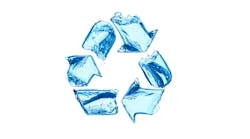Q
Is home water treatment really necessary and beneficial?
A
Home water treatment has a range of applications from taste and odor improvement, iron and particle removal, softening and TDS reduction and chemical reduction to removing pathogens to reduce waterborne disease risk and also, as final barrier protection, if it is properly designed and maintained. Those can all provide potential benefits that range from aesthetic consumer choices to health and safety. They all depend upon making the right treatment selection related to the problem to be solved, and proper maintenance and service. I’ll briefly describe some of the common applications and emphasize those that provide real health risk reduction, including the World Health Organization’s (WHO) Household Water Treatment Initiative.
Aesthetic water quality
Some U.S. consumers buy POU devices for drinking water because of a perceived health risk, but most probably do it because of dissatisfaction with the water’s taste. Almost all public water suppliers in the U.S. strive to provide safe and good tasting water, but taste is still a secondary issue for many of them. Chlorine residuals that help with assuring safe water are noticeable because the taste threshold for free chlorine in water is quite low for some people, on the order of 0.15 ppm, and chloramine is about 0.5 mg/l. Some organics like chlorophenol have taste thresholds in the 1 or 2 ppb level and others like methylisoborneol and geosmin from algae are detectable by some in the 5 to 10 ppt range. MTBE the gasoline additive that can get into groundwater is as low as 5 ppb.
Fortunately, there are widely available and low cost POU/POE technologies that are effective in providing significant taste improvements that make the drinking water at the tap much more desirable. They tend to be carbon block or granular carbon in POU/POE devices or in pitcher filters and refrigerator ice and water units. They have good service life and it is obvious when they stop working. They will allow growth of heterotrophic plate count (HPC) microorganisms because they eliminate the chorine residual. However, HPCs in water are generally not considered to be harmful by the World Health Organization. A first flush can easily reduce the counts in the glass, if desired.
Salts, hardness, TDS and particulates
Iron, manganese and particulates are major nuisances and hard water has both aesthetic and economic consequences as well as possible dermal irritation issues. In-line iron and particle filters are very low cost and effective. Of course, the incoming particles that are present must not be associated with any water treatment deficiency. Cation exchange water softeners are widely used as POE devices; they replace cations like calcium and magnesium with sodium ions. They also remove regulated ions like barium and radium. They provide benefits with regard to lathering and rinsing and possibly reduced eczema, as well as reduced scale in water heaters. There are cautions for persons who are on low sodium diets; calcium and magnesium are essential to health, so it is important to have sufficient dietary intakes. Use of cation exchange water softeners is under pressure in some areas because of the high salt content of the regenerant water that is discharged to sewers or to the ground from septic tanks.
Total dissolved solids (TDS) can seriously detract from drinking water’s aesthetic acceptability. Bottled mineral waters have high TDS of ions that are desirable for some people, but tap water with high TDS has negative aspects. The TDS secondary drinking water standard is 500 ppm, but water becomes increasingly unpalatable as levels approach and exceed 1000 ppm, as well as causing probable scaling problems. POU reverse osmosis devices remove most ions, but with low efficiency and high water rejection, because they operate at low pressure. However, in some circumstances they may be the only feasible choice along with bottled water.
Organic chemicals
The majority of organic chemicals in water are natural and they make up the TOC measured in ppm. However, some are contaminants at the ppb or ppt levels and most of them in public water supplies are disinfection by-products (DBPs) like THMs and HAAs. Whether there are significant long-term health risks is open to debate, but those two chemical groups are regulated principally as indicators of the potential presence of other DBPs. Public concern has also been raised by reports of the presence of trace levels of some pharmaceuticals and consumer care products (PPCPs) in some waters. Their presence is probably of negligible health concern, but POU and POE treatments that are carbon-based or RO membrane-based have the capability of reducing the presence of many of those organic chemicals. Ozonation processes also decompose many of those chemicals. Proper maintenance and cartridge replacements are necessary to assure continued performance.
Decentralized treatment by application of POU in each home is a viable approach for regulatory compliance in small communities. Success has been demonstrated when managed by a qualified contractor.
Microbial disease risks
The risk of contracting a waterborne disease from public drinking water supplies in the U.S. is minute, but not zero. Since the introduction of disinfection and filtration in the early 20th century, waterborne disease has been virtually eliminated as a significant concern, but cases and outbreaks still occur occasionally. The incidence of outbreaks has been reduced since the implementation of the Safe Drinking Water Act in the 1970s, but the massive outbreak of disease from cryptosporidium contamination in Milwaukee is a reminder that mistakes do happen. In that outbreak, it was reported that people who had the appropriate one micron filters in their homes had a reduced risk of the disease. So, the concept of final barrier protection has value in situations where sufficient risk exists.
Private wells are orphaned in many respects because they are usually not seriously regulated, but they are worth much greater diligence and treatment in many cases. Residents are often not aware that there is a problem. Septic tanks and surface percolation can be sources of microbial contaminants and chemicals like nitrate and pesticides. They require more investigation and selection of the appropriate treatment for the water quality problems that are discovered. UV might be the most convenient choice in those situations. Although there are identifiable areas to be examined, many of the problems will be site-specific. Water treatment professionals have an opportunity to provide a valuable service if they are knowledgeable about the science and problems and technologies that will solve them.
Household water treatment and safe storage – World Health Organization
The major concerns for microbial waterborne disease are still prevalent in regions outside of the U.S, Canada and much of Europe and Japan and some other developed countries where public drinking water is well managed. That includes both residents and travelers in those high risk regions.
According to the World Health Organization, every year there are about two million diarrheal deaths related to unsafe water, sanitation and hygiene — the vast majority among children under five years old. More than one billion people lack access to an improved water source.
WHO established the International Network to Promote Home Water Treatment and Safe Storage (HWTS) in 2003. HWTS interventions can lead to dramatic improvements in drinking water quality and reductions in diarrheal disease, making an immediate difference to the lives of those who rely on water from polluted rivers, lakes and, in some cases, unsafe wells or piped water supplies. This was a novel approach because prior to that time the philosophy was that every community should build a water treatment plant to have access to safe water. That was obviously impossible both for practicality and cost reasons and history had shown that it was not viable.
People were getting sick and dying while waiting for some organization to decide to build a water plant and frequently water plants would fall into disrepair due to lack of operating personnel and parts. Travelers in those areas have the same or worse problems because they do not even have any acquired immunity that might exist among locals. Many locals purchase local bottled water at significant cost and of questionable quality. Users can benefit if they can control their own drinking water quality. Both pour through and in-line devices can be appropriate and dissemination of information on simple techniques can reduce illnesses and save lives.
The HWTS network’s stated mission is, “To contribute to a significant reduction in waterborne disease, especially among vulnerable populations, by promoting household water treatment and safe storage as a key component of water, sanitation and hygiene programmes. The informal network format optimizes flexibility, participation and creativity to support coordinated action.”
UNICEF is now co-hosting with WHO. I am a member and I recommend that you consider joining, it’s free and you can participate to any extent that it is in your interest. Information is available at http://www.who.int/household_water/en/.
Conclusion
POU and POE in the home can provide benefits when geared to addressing the specific water quality issue and properly informing buyers. Sellers need to be knowledgeable about how to identify the problems and recommend the correct solutions. Good management of the system is essential for good results. Private home wells are usually safe, but also possibly an untapped opportunity for business and to improve the safety of the water supply for the residents when they need help. Introducing disinfection could be the greatest benefit in many cases. The HWTS is an opportunity to engage in the greater worldwide effort to provide safe drinking water and to reduce the unconscionable death and disease that continues to occur for millions who do not have the wherewithal or government support to reduce their risks from contaminated water.
Dr. Cotruvo is president of Joseph Cotruvo and Associates, LLC, Water, Environment and Public Health Consultants. He is a former director of the U.S. EPA Drinking Water Standards Division.


